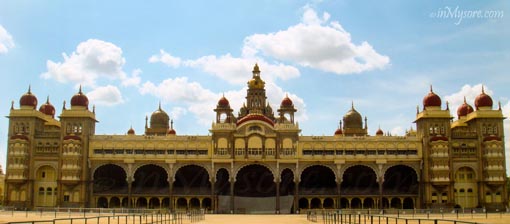Mysore Palace

Information on Mysore Palace (Mysore, Karnataka) - History & Architecture
Mysore Palace is one of the grandeur and most remarkable memorials of Mysore. It is also termed as Amba Vilas. Mysore Palace was the official residence of the king of Mysore during the period of 1399 to 1950. The palace also comprises ritual conference halls, an enormous courtyard, a garden and various constructions. Mysore is commonly known for 'City of Palaces' and among the many splendid and architectural beautiful palace, Mysore Palace is one of them, which is the major landmark of Mysore city. One of the most amazing features of Mysore Palace is its lighting at night. It consumes about 97000 bulbs in order to generate captivating image of the palace at night.
Mysore Palace Architecture
Mysore Palace has hybrid architectural style, i.e. the structure of the palace is the mixture of several designs. The style on which the construction of Mysore Palace was based is termed as Indo-Saracenic style. Mysore Palace is a mixture of Hindu, Islamic, Rajput and Gothic architectures. It is a three storied building, having marble ceilings and one 145 foot tall tower. The palace is fenced by a big garden. The building of the palace is developed with grey brickwork and deep pink marble roofs. The front side of Mysore Palace has seven extensive curves, with two smaller curves, adjoining the central arch. The central arch of the palace is supported by big columns. Above the central arch of Mysore Palace, there is an inspiring statue of Gajalakshmi with elephants, which is also termed as the divinity of affluence, prosperity, fortuity and profusion.
Mysore Palace History
Mysore Palace was first established by king Yaduraya in 14th century. However, the palace was demolished several times. Historic article declares that Mysore Palace was first damaged by lightning and it was rebuilt by king Ranadheera Kantheerava in 1638. After one century, the power of Mysore moved to Hyder Ali and his renowned son Tippu Sulthan. It was the era of chaos in Mysore, since Tippu Sulthan was challenging the extensive determinations of the British East India Company. During his rule, Tippu Sulthan had destroyed the architecture of Mysore Palace for giving way his new capital, i.e. Nazarabad. He also established new barricades in Nazarabad. Tippu Sulthan demised in the year 1799, by storming power of British forces. The collapse of Tippu Sulthan virtually highlighted the fall of last king in India who defied the British authority. Afterwards, the capital shifted back to Mysore city and the barricades which established around Nazarabad was also demolished. The stones that were utilised for creating those barricades were used for creating the present Mysore Palace. The construction of new Mysore Palace was completed in the year 1803. In the year 1897, again the palace was damaged due to fire outbreak. In the same year, the creation of new palace was inducted. By 1912, the creation of new Mysore Palace was finished. In later days, several additions were also made to Mysore Palace by Krishnaraja Wodeyar IV. He attributed with the development of royal construction in Mysore Palace.
Mysore Palace Tourism Importance
The present Mysore Palace is regarded as the fourth palace due to its various demolitions. It is one of the most magnificent tourist attractions in Mysore. Furthermore, it is also said that the attractiveness of Mysore Palace as tourism place come in after Taj Mahal. It possesses 3 million visitors in a year due to its unique architecture and designs. If you want to witness the beauty at its best of Mysore Palace, visit this Palace during the time of Dusshera and Diwali and you will witness something which is surely going to leave you speechless.
- Bangalore Monuments
- Bagalkot Monuments
- Belgaum Monuments
- Bellary Monuments
- Bidar Monuments
- Bijapur Monuments
- Chitradurga Monuments
- Coorg Monuments
- Dakshina Kannada Monuments
- Gadag Monuments
- Gulbarga Monuments
- Hassan Monuments
- Mysore Monuments
- Raichur Monuments
- Uttara Kannada Monuments
- Yadgir Monuments
- Andaman Nicobar Monuments
- Andhra Pradesh Monuments
- Assam Monuments
- Bihar Monuments
- Chhattisgarh Monuments
- New Delhi Monuments
- Goa Monuments
- Gujarat Monuments
- Haryana Monuments
- Himachal Pradesh Monuments
- Jammu and Kashmir Monuments
- Karnataka Monuments
- Kerala Monuments
- Madhya Pradesh Monuments
- Maharashtra Monuments
- Odisha Monuments
- Punjab Monuments
- Rajasthan Monuments
- Tamil Nadu Monuments
- Telangana Monuments
- Uttar Pradesh Monuments
- West Bengal Monuments